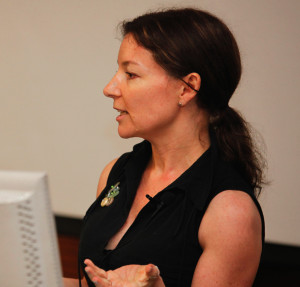The Renascence of the Sensual in a Vivacious World
The implications of cloud phenomena and molecular aesthetics conjure macro and micro perspectives, which resonate in the author’s research into haptic interface aesthetics and open systems. Physics describes the world’s natural state as one of entropy, where clusters of order are the result of the living organism or the machine’s ability to make decisions to create local zones of organisation [1]. The author’s a/r/tographic [2] work in humanistic intelligence [3], through haptic interfaces or reconstructed sensas [4], has led to consideration of materials in terms of non-static manifestations. This presentation discusses the potential of this shift in perspective to open new spaces for artists to work and new vivacious materials to sculpt with.
What was once considered a dormant and stable medium will be perceptibly in motion, we will hear, touch and feel it in ways previously unperceivable. The primacy of the ocular era will be overthrown and our bodies will witness a renaissance of the sensual. The future is in the cloud where micro and macro events are instantaneously understood in comparative terms to their human scale implications. Nanotechnologies enable us to engage with tangible materials enhancing our capacity to sense molecular activity. Material substrates’ visual hold, that has engaged our attention since the enlightenment, is veiling the true nature of matter. The moving image is the motorization of painting [5]. It supersedes static in its interactive engagement with information. Through digital technologies[6] – motorization of society – the Internet of things and smart cities, smart citizens will experience ‘vibrant matter’ [7].
1. WIENER, N. (1989) The human use of human beings: cybernetics and society, Free Association London. p. 34.
2. IRWIN, R.L., BEER, R., SPRINGGAY, S., GRAUER, K., XIONG, G. and BICKEL, B., 2006. The Rhizomatic Relations of A/r/tography. Studies in Art Education, 48(1), pp. 70-88
3. …where bio-data and computers communicate directly. MANN, S., 2001. Wearable computing: toward humanistic intelligence. IEEE Intelligent Systems, 16(3), pp. 10-15.
4. “… now it’s a machine that’s reconstructing sensations pixel by pixel and bits by bits. Not just visual or auditory sensations, the audio-visible, but also olfactory sensations, tactile sensations. We are faced with a reconstruction of the sensas.
“Sensas” are the basis of sensations the way we say psyche, etc.” VIRILIO, P; LOTRINGER, S. (2005) The Accident of Art, Semiotext(e) p.66.
5. (Virilio, Lotringer 2005) p.66.
6. BURNHAM, J. (2005) Systems Esthetics, Tate, London.
Patricia Flanagan has been exhibiting internationally since the mid 1990’s and is represented in private and public collections in Australia, Ireland, Germany, Italy and China. She is the winner of four CASP funded Public Art commissions, a UGCTD Grant to develop PIPA; representative for Oceania at the Tournai Contemporary Textiles Biennial Belgium; recipient of the Australian Postgraduate Scholarship Award and winner of The Max Fabre Foundation Award for Environmental Awareness. She completed a Doctorate of Philosophy (Public Art) University of Newcastle Australia; Master of Art (Visual Art) Bauhaus University Weimar; Bachelor of Arts (Fine Art) and Associate Diploma awarded with honours (Fashion Design). Her research in human computer interaction is widely published and she is on the programing committee for HCI – Design User Experience and Usability. Dr. Flanagan established the Wearables Lab at the Academy of Visual Art at HKBU in 2009 where she currently works as Assistant Professor.
